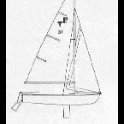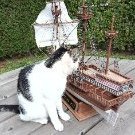-
Posts
328 -
Joined
-
Last visited
Reputation Activity
-
 Stevinne reacted to Keith Black in Roter Lowe by Stevinne - Mamoli - 1:55 - Dutch-built Galleon
Stevinne reacted to Keith Black in Roter Lowe by Stevinne - Mamoli - 1:55 - Dutch-built Galleon
That's a face full of curiosity right there. Cute little mutt, does she sleep snuggled up?
-
 Stevinne got a reaction from Baker in Roter Lowe by Stevinne - Mamoli - 1:55 - Dutch-built Galleon
Stevinne got a reaction from Baker in Roter Lowe by Stevinne - Mamoli - 1:55 - Dutch-built Galleon
I haven't had much time to work on the ship for the past couple of weeks. The pressgang brought aboard a new shipmate. She's still a grass-combing lubber who can't hand, reef or steer and requires a lot of attention and our free time, but she's fast as a whip and will surely play havoc with the bread room rats (and the squirrels outside, though she's not really much larger).
-
 Stevinne got a reaction from Canute in Realistic Galleon Painting Question
Stevinne got a reaction from Canute in Realistic Galleon Painting Question
That's the same technique they used on a lot of the gold materials found in King Tut's tomb. I saw an exhibit of the items many years ago and the coolest part was that once you got up close, you could see the impressions left on the gold leaf by the fingers of the people who applied it. As for the support brackets on the galleon, I'd think that's the manufacturer deciding it would be easier to provide cast pieces instead of carved wood.
-
 Stevinne got a reaction from ERS Rich in It's not going well, Lady Nelson
Stevinne got a reaction from ERS Rich in It's not going well, Lady Nelson
Instead of a rabbet, you can bevel the inside of the underside edge of the plank. I have done that in the past and it gave a nice, tight fit. I do the same thing with the front edge of the plank, again so it lays nicely flat against the keel.
Are you starting your planking at the front of the ship, working backward? That allows you to get a good, strong attachment first, and once you achieve that then you can work backward.
My preferred method is to bend the plank to shape as much as possible and then use CA glue on the front of the plank, and the first pair of bulkheads while I paint and the bow filler blocks with wood glue. I attach it, hold it in place until the CA grabs and dries and then apply pins to hold it into place while the wood glue dries up. Once enough time has passed I then move on to attaching the rest of the plank in a similar fashion, doing a couple of bulkheads and allowing for drying time. Once all is dry, I then break out the wood glue again and use the opening in the hull from the missing planks to paint some wood glue on the bulkheads to reinforce the CA. I let that dry.
I use the same technique on subsequent planks, with the only difference being that I paint the top of the plank with wood glue and push it up tight against the upper plank to both ensure a snug fit and allow the glue to solidify the hull.
Frank Mastini's "Ship Modeling Simplified" offers great advice on planking (and just about everything else for someone starting out in the hobby).
-
 Stevinne got a reaction from mtaylor in Realistic Galleon Painting Question
Stevinne got a reaction from mtaylor in Realistic Galleon Painting Question
That's the same technique they used on a lot of the gold materials found in King Tut's tomb. I saw an exhibit of the items many years ago and the coolest part was that once you got up close, you could see the impressions left on the gold leaf by the fingers of the people who applied it. As for the support brackets on the galleon, I'd think that's the manufacturer deciding it would be easier to provide cast pieces instead of carved wood.
-
 Stevinne got a reaction from catopower in It's not going well, Lady Nelson
Stevinne got a reaction from catopower in It's not going well, Lady Nelson
Instead of a rabbet, you can bevel the inside of the underside edge of the plank. I have done that in the past and it gave a nice, tight fit. I do the same thing with the front edge of the plank, again so it lays nicely flat against the keel.
Are you starting your planking at the front of the ship, working backward? That allows you to get a good, strong attachment first, and once you achieve that then you can work backward.
My preferred method is to bend the plank to shape as much as possible and then use CA glue on the front of the plank, and the first pair of bulkheads while I paint and the bow filler blocks with wood glue. I attach it, hold it in place until the CA grabs and dries and then apply pins to hold it into place while the wood glue dries up. Once enough time has passed I then move on to attaching the rest of the plank in a similar fashion, doing a couple of bulkheads and allowing for drying time. Once all is dry, I then break out the wood glue again and use the opening in the hull from the missing planks to paint some wood glue on the bulkheads to reinforce the CA. I let that dry.
I use the same technique on subsequent planks, with the only difference being that I paint the top of the plank with wood glue and push it up tight against the upper plank to both ensure a snug fit and allow the glue to solidify the hull.
Frank Mastini's "Ship Modeling Simplified" offers great advice on planking (and just about everything else for someone starting out in the hobby).
-
 Stevinne got a reaction from thibaultron in Realistic Galleon Painting Question
Stevinne got a reaction from thibaultron in Realistic Galleon Painting Question
That's the same technique they used on a lot of the gold materials found in King Tut's tomb. I saw an exhibit of the items many years ago and the coolest part was that once you got up close, you could see the impressions left on the gold leaf by the fingers of the people who applied it. As for the support brackets on the galleon, I'd think that's the manufacturer deciding it would be easier to provide cast pieces instead of carved wood.
-
 Stevinne got a reaction from Keith Black in Roter Lowe by Stevinne - Mamoli - 1:55 - Dutch-built Galleon
Stevinne got a reaction from Keith Black in Roter Lowe by Stevinne - Mamoli - 1:55 - Dutch-built Galleon
I haven't had much time to work on the ship for the past couple of weeks. The pressgang brought aboard a new shipmate. She's still a grass-combing lubber who can't hand, reef or steer and requires a lot of attention and our free time, but she's fast as a whip and will surely play havoc with the bread room rats (and the squirrels outside, though she's not really much larger).
-
 Stevinne reacted to ccoyle in I beg your pardon, I'm afraid you have the advantage of me...
Stevinne reacted to ccoyle in I beg your pardon, I'm afraid you have the advantage of me...
Welcome aboard! I'd bet dollars to doughnuts that your grandfather's model is the old Artesania Latina Harvey kit, a generic Baltimore clipper. Plans for her are probably easily obtained on eBay (the kit was very popular back in the day). You might also find the book Rigging Period Fore-and-Aft Craft by Lennarth Petersson valuable.
-
 Stevinne reacted to captgino in Mayflower by captgino - FINISHED - Model Shipways - 5/32 Scale
Stevinne reacted to captgino in Mayflower by captgino - FINISHED - Model Shipways - 5/32 Scale
Finally done
-
 Stevinne reacted to Baker in Mary Rose by Baker - scale 1/50 - "Your Noblest Shippe"
Stevinne reacted to Baker in Mary Rose by Baker - scale 1/50 - "Your Noblest Shippe"
With all frames made thinner and the last planks attached to the stern, the rough shape of the hull and rear castle is largely finished.
A lot of wood chips.. And the first jar of PVA glue is empty
With paint pots visible in the background, time for some freshening up of the hobby room.
Current status with a cardboard fore castle
-
 Stevinne reacted to TBlack in HMS Sophie by TBlack - kit-bashing Jack Aubrey's first command from the Vanguard Models HMS Speedy
Stevinne reacted to TBlack in HMS Sophie by TBlack - kit-bashing Jack Aubrey's first command from the Vanguard Models HMS Speedy
Bob,
I appreciate your lengthy and in-depth reply. My source of information is the book Master And Commander. The Sophie, unlike the Speedy, had a quarterdeck and a captain's cabin. She was, in fact, the former Spanish brig Vincejo (Trans: swift) which, in real life, had a quarterdeck and a captain's
cabin.
What I have done is buy the Speedy kit from Chris Watton and intend to alter it to allow for the changes to the aft portion (this is a little like taking the Mona Lisa and painting a mustache on her). And I think I will handle the stern like the Fair American, that is, the outboard windows will be fake.
Tom
-
 Stevinne got a reaction from GrandpaPhil in Roter Lowe by Stevinne - Mamoli - 1:55 - Dutch-built Galleon
Stevinne got a reaction from GrandpaPhil in Roter Lowe by Stevinne - Mamoli - 1:55 - Dutch-built Galleon
It's been a while since I've posted, but I have been at work, slogging through attaching the ratlines. This is my first galleon build, and this ship has six shrouds on the lower foremast and seven on the mainmast. That compares to four on each for my Constructo Enterprise and Le Reynard cutter - so lots more tying of very small knots. Once I was done, I painted the whole assembly with diluted carpenter's glue to help keep the knots together. Futtock shrouds are next.
-
 Stevinne got a reaction from Ronald-V in Roter Lowe by Stevinne - Mamoli - 1:55 - Dutch-built Galleon
Stevinne got a reaction from Ronald-V in Roter Lowe by Stevinne - Mamoli - 1:55 - Dutch-built Galleon
It's been a while since I've posted, but I have been at work, slogging through attaching the ratlines. This is my first galleon build, and this ship has six shrouds on the lower foremast and seven on the mainmast. That compares to four on each for my Constructo Enterprise and Le Reynard cutter - so lots more tying of very small knots. Once I was done, I painted the whole assembly with diluted carpenter's glue to help keep the knots together. Futtock shrouds are next.
-
 Stevinne got a reaction from Baker in Roter Lowe by Stevinne - Mamoli - 1:55 - Dutch-built Galleon
Stevinne got a reaction from Baker in Roter Lowe by Stevinne - Mamoli - 1:55 - Dutch-built Galleon
It's been a while since I've posted, but I have been at work, slogging through attaching the ratlines. This is my first galleon build, and this ship has six shrouds on the lower foremast and seven on the mainmast. That compares to four on each for my Constructo Enterprise and Le Reynard cutter - so lots more tying of very small knots. Once I was done, I painted the whole assembly with diluted carpenter's glue to help keep the knots together. Futtock shrouds are next.
-
 Stevinne got a reaction from JacquesCousteau in Roter Lowe by Stevinne - Mamoli - 1:55 - Dutch-built Galleon
Stevinne got a reaction from JacquesCousteau in Roter Lowe by Stevinne - Mamoli - 1:55 - Dutch-built Galleon
It's been a while since I've posted, but I have been at work, slogging through attaching the ratlines. This is my first galleon build, and this ship has six shrouds on the lower foremast and seven on the mainmast. That compares to four on each for my Constructo Enterprise and Le Reynard cutter - so lots more tying of very small knots. Once I was done, I painted the whole assembly with diluted carpenter's glue to help keep the knots together. Futtock shrouds are next.
-
 Stevinne got a reaction from Keith Black in Roter Lowe by Stevinne - Mamoli - 1:55 - Dutch-built Galleon
Stevinne got a reaction from Keith Black in Roter Lowe by Stevinne - Mamoli - 1:55 - Dutch-built Galleon
It's been a while since I've posted, but I have been at work, slogging through attaching the ratlines. This is my first galleon build, and this ship has six shrouds on the lower foremast and seven on the mainmast. That compares to four on each for my Constructo Enterprise and Le Reynard cutter - so lots more tying of very small knots. Once I was done, I painted the whole assembly with diluted carpenter's glue to help keep the knots together. Futtock shrouds are next.
-
 Stevinne got a reaction from FrankWouts in HMS Prince by myxyzptlyk2003 - Mamoli - 1/144
Stevinne got a reaction from FrankWouts in HMS Prince by myxyzptlyk2003 - Mamoli - 1/144
A shame. I'd been thinking about this kit as a future build somewhere down the line, since I also thought the scale would be a good fit in my house. One good thing about following build logs is being forewarned.
-
 Stevinne reacted to Baker in Golden Hind (ex-Pelican) by Baker - FINISHED - scale 1/45 - Galleon late 16th century
Stevinne reacted to Baker in Golden Hind (ex-Pelican) by Baker - FINISHED - scale 1/45 - Galleon late 16th century
The futtock shrouds (indeed, the further you go back in time, the less you can do wrong 😉)
I chose to place an eye bolt with hook. More work to make eyebolts but easier to mount the rope to the deadeye.
The build of kirrill's Spanish Galleon was very helpfull
https://modelshipworld.com/topic/6262-spanish-galleon-1607-by-kirill4-lee-plastic-1100/?do=findComment&comment=182546
Replace one ratline with a futtock stave. It wasn't uncommon that there were still ratlines above this futtock stave
Work in progress
ready
And work started on a display stand
Thanks for following, comments and likes.
-
 Stevinne reacted to Baker in Roter Lowe by Stevinne - Mamoli - 1:55 - Dutch-built Galleon
Stevinne reacted to Baker in Roter Lowe by Stevinne - Mamoli - 1:55 - Dutch-built Galleon
Saved by Kirill post 578, second time 😉 👍
-
 Stevinne reacted to kirill4 in Roter Lowe by Stevinne - Mamoli - 1:55 - Dutch-built Galleon
Stevinne reacted to kirill4 in Roter Lowe by Stevinne - Mamoli - 1:55 - Dutch-built Galleon
Good day Stevinne,
Your plan sounds good!
Don't forget to reinforce top construction, perhabs need to install some wooden or metal pins in some critical points to create reliable connection of top elements ?
When I did my rigging, I don't remember issues with shrouds twisting, but I try to avoid as much as possible to create any tensions or load on shrouds and other standing rigging( due to plastic masts and spars of my model)... all were done with applying minimum "forces" if we could say that, moreover, as I mentioned early, do better to paint all threads You use for rigging befor use... it could be painted by mix of artistic oil paints deluted in tick oil and thinner or by acryl artistic paints of suitable colors... actualy we need two colors for our purposes, bright for running rigging and dark for standing...
There is a receipt from one of high level modeller , how he paints his rope:
"...for coloring white threads with artistic oil paints, you can dilute the composition in half a liter container, for example - a tube of paint is mixed with liquid oil - teak, for example (you can add more white spirit - to make the composition more liquid) Natural umber is used for standing rigging. On running, ocher is added to this paint.
It is dyed by pulling a thread through a can or a poured puddle of paint. Then the thread is pulled several times through the cotton glove and hung out to dry. Can be used in a day.
One of the Model of Dmitry Shevelev https://www.shipmodeling.ru/phpbb/viewtopic.php?p=370243#p370243
Before painting or even when threads were painted and still wet and hanging for drying, it could be loaded a little with weight of some steel bolts or nuts which will release internal tensions some times remains in thread ... that also will help to avoid twisting effect...
All the Best!!!
Kirill
Ps
There is sence to check which kind of thread used for shrouds - right or left hand made and how it passes around desdeyes - clockwise or counterclockwise direction when fitted?
Details You could found in Anderson book.
-
 Stevinne got a reaction from Keith Black in Roter Lowe by Stevinne - Mamoli - 1:55 - Dutch-built Galleon
Stevinne got a reaction from Keith Black in Roter Lowe by Stevinne - Mamoli - 1:55 - Dutch-built Galleon
You're right about the futtock shrouds. My plan is to do the ratlines on the lower shrouds and then attach the futtocks. In retrospect, perhaps I should have completed the lower shrouds, ratted them and attached the futtocks before I moved on to the topmast. That would have prevented another issue I had with the topmast shrouds, which was the lower deadeyes twisting as I rigged the upper deadeyes. Oh well, live and learn.
-
 Stevinne got a reaction from Baker in Roter Lowe by Stevinne - Mamoli - 1:55 - Dutch-built Galleon
Stevinne got a reaction from Baker in Roter Lowe by Stevinne - Mamoli - 1:55 - Dutch-built Galleon
I've been slogging through attaching shrouds and thought I was making progress. But, when I went to gather the foremast top shrouds, the top ring of the foremast top came loose, requiring some gluing and clamping. I'd been really careful when originally putting the top together to make sure everything lined up and looked good. Now I fear what things will look like when I remove the clamps.
-
 Stevinne got a reaction from Keith Black in Roter Lowe by Stevinne - Mamoli - 1:55 - Dutch-built Galleon
Stevinne got a reaction from Keith Black in Roter Lowe by Stevinne - Mamoli - 1:55 - Dutch-built Galleon
Krill, I'd originally had the lower mainmast stay rigged as you describe, that is what is called for in the plans, but I was concerned because things were rubbing against the top of the focsle. I looked around for alternatives and found some Golden Hind build logs and copied their approach. The main top stay is rigged as per the plans, though having worked with these plans for many years, I increasingly find that to be little comfort.
-
 Stevinne got a reaction from Keith Black in Roter Lowe by Stevinne - Mamoli - 1:55 - Dutch-built Galleon
Stevinne got a reaction from Keith Black in Roter Lowe by Stevinne - Mamoli - 1:55 - Dutch-built Galleon
I've been slogging through attaching shrouds and thought I was making progress. But, when I went to gather the foremast top shrouds, the top ring of the foremast top came loose, requiring some gluing and clamping. I'd been really careful when originally putting the top together to make sure everything lined up and looked good. Now I fear what things will look like when I remove the clamps.











